|
1981
|
Pouring the first concrete
|
|
| |
An exhibition centre opens to the public in October 1981 and the Prime Minister the Rt Hon. Malcolm Fraser (LP, Member for Wannon, Vic., 1955‒83) pours the first concrete in November, marking the start of the construction phase.
Due to the length of time taken for the design competition, the timeframe for construction is compressed and the Parliament House Construction Authority adopts a 'fast track' process whereby the design and construction processes are undertaken concurrently. This is an unusual arrangement, and puts pressure on the architects to keep ahead of construction. [1]
|
|
|
1981
|
Construction begins
|
|
| |
Major earthworks begin on the New Parliament House building, with plans to complete it by Australia Day in 1988 in the bicentennial year of European settlement in Australia.
The building area comprises 7.5 hectares within a 32-hectare site, is the largest construction site in the Southern Hemisphere at this time. Ten thousand Australians are involved in its construction-many still return periodically to celebrate their work. [2]
|
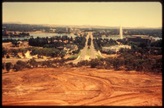
Commonwealth Avenue from Capital Hill, 1981
Image courtesy of National Library of Australia
|
| 1982 |
Art Advisory Committee appointed |
|
|
An Art Advisory Committee is appointed in February 1982, and an ethos is developed for the building. [3]
During construction, artists, craftspeople and fabricators collaborate closely with the architects and the Parliament House Construction Authority in a program to design and install some 70 separate works in metal, timber, clay, glass, fabric and stone, each devised for a particular location. [4] As the architect Romaldo Giurgola describes it:
There must be a slow and deliberate fusion of the spaces, materials and surfaces into an environment in which all elements read together in a rich and mutually descriptive way….an integral part of the process of development of the interior design. [5]
The Parliament House Art Collection evolves into a major public collection of significant heritage value, created specifically for Parliament House, and containing a number of sub-collections.
|
|
|
1982
|
Non-building items authorised
|
|
| |
In July 1982 the Parliament House Construction Authority is authorised to undertake non-building items including communications and security equipment, artworks and furniture and furnishings, with an estimated budget of $82 million.
|
|
|
1983
|
Open Days
|
|
| |
In January 1983 the Parliament House Construction Authority conducts the first of nine public Site Open Days. [6]
|
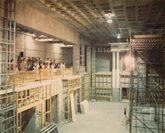
Untitled (visitors inside building under construction)
Image courtesy of Parliament House Art Collection, Canberra ACT
|
|
1983
|
Foundation stone laid
|
|
| |
On 4 October 1983 Prime Minister the Hon. Bob Hawke (ALP, Member for Wills, Vic., 1980‒92) lays the foundation stone for the new building.
|
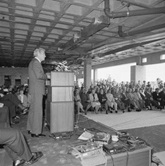
Bob Hawke at Foundation Stone ceremony at new Parliament House
Image courtesy of National Archives of Australia
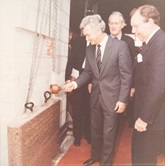
Untitled (Prime Minister Bob Hawke laying the foundation stone with mallet, Parliament House)
Image courtesy of Parliament House Art Collection, Canberra ACT
|
|
1983
|
Forecourt mosaic commissioned
|
|
| |
The architects, Mitchell/Giurgola & Thorp, commission the Forecourt mosaic, one of a number of architectural commissions for the new building.
The mosaic is designed by Indigenous artist Kumantye Jagamara [Tjakamarra], a leading artist from the Papunya community of the Northern Territory. The design of the mosaic is based on his painting Possum and Wallaby Dreaming. It ‘describes a gathering of a large group of people from the kangaroo, wallaby and goanna ancestors. The groups are meeting to talk and to enact ceremonial obligations. The work derives from the sand-painting tradition of the Warlpiri people, and has complex layers of meaning known only to Warlpiri elders’. The mosaic takes stonemasons William McIntosh, Franco Colussi and Aldo Rossi 18 months to complete. [7] According to the architects:
Both the imagery and style of the Papunya painters are especially appropriate to this location, since the iconography of their paintings is frequently one of itineraries through the landscape, of special powers associated with particular places, and of moments of meeting and coming together. [8]
|

Untitled (a construction worker hosing the completed Michael Nelson Jagamara mosaic in forecourt of Parliament House)
Image courtesy of Parliament House Art Collection, Canberra ACT
|
|
1983
|
Increase in size of Houses
|
|
| |
With the passage of the Representation Act 1983, the number of senators is increased to 12 for each original state (effective from the December 1984 election), and the membership of the House is increased from 125 to 148.
Section 24 of the Constitution (known as the nexus provision) provides that the number of members of the House of Representatives must be twice the number of senators, or as near as practicable. This ensures that the House of Representatives does not become disproportionately large in relation to the Senate. The Parliament has legislated only twice since Federation (in 1948 and 1983 respectively) to change the number of members in both Houses. Redistributions increase the number of members to 150 from the 2001 general election. [9]
|
|
|
1984
|
Strike by construction workers
|
|
| |
Workers on the New Parliament House construction site strike for 14 weeks between February and May 1984 over negotiations on the Site Agreement. [10]
|
|
|
1984
|
Provisional Parliament House saved
|
|
| |
In May 1984 the Joint Standing Committee on the New and Permanent Parliament House recognises the provisional Parliament House's heritage values and recommends that it not be demolished. The chief architect, Romaldo Giurgola, strongly supports this view. The Committee notes that 'a major part of Australia's post-Federation political history has been written in the building and it has a further useful life'. Its Report on the Future Use of the Provisional Parliament House recommends that the building not be demolished:
The most appropriate future use would be as a museum related to the Australian Constitution, Federation and the Commonwealth Parliament. [11]
The building is subsequently added to the Commonwealth Heritage List in 2004 and the National Heritage List in 2006. Its national heritage significance includes its place in the development of Australia as a nation from its opening in 1927 until the opening of the new Parliament House in 1988, including landmark national legislation and political events shaping Australian society.[12] On 9 May 2009, Old Parliament House opens to the public as the Museum of Australian Democracy.
|
|
|
1984
|
Provisional Parliament house extensions
|
|
| |
Extensions are approved in July 1984 for the provisional Parliament House to provide an additional 24 senators' and 30 members' suites, following an increase in representation in the Senate and House of Representatives. [13]
Space is at a premium. By 1983 some 3000 people are working in the building, with more than half being accommodated in various former hostels and other nearby buildings. In 1984, two verandahs at the front of the building are enclosed to provide extra office space. In 1985 an annex is built in the House of Representatives gardens to provide additional accommodation. [14] According to Senator the Hon. John Button (ALP, Senator for Victoria, 1974‒93):
In Parliament House members work in small crowded rooms painted in Education Department cream and furnished with uniform carpets, railway station furniture, a tramways clock, and an elaborately complex system of division bells designed, one suspects, by Thomas Edison….Apart from cramped physical conditions a member is constantly subject to the hazards of air and noise pollution-the former from a ferocious central heating system which dries the throat and saps the energy (one suspects a hidden malevolent hand), and the latter from the ubiquitous division bells. In my own case relief from the central heating is provided only by a heavy shower of rain, which pours through the roof of my office, necessitating the removal of books and papers and their replacement by buckets. [15]
|
|
|
1984
|
Great Hall tapestry commissioned
|
|
| |
Renowned Australian artist, Arthur Boyd (1920‒99), is commissioned by the Parliament House Construction Authority to create a painting as the design for a tapestry to hang in the Great Hall.
The architectural vision for the Great Hall-a space intended for ceremonial and state occasions- is for it to convey a sense of the Australian land emphasising the importance of the physical environment in shaping Australian values. Boyd produces three large canvases, one-quarter the scale of the finished tapestry, as designs for the commission. Untitled (Shoalhaven Landscape) 1984 is selected as the design, and the Victorian Tapestry Workshop in Melbourne is chosen to create the tapestry based on Arthur Boyd's design. It is one of the largest tapestries in the world, and takes a team of 13 weavers two and a half years to complete the work. [16] Halley's Comet (Comet Halley), which is visible in the southern hemisphere in late 1985 and early 1986, is incorporated into the tapestry during the weaving process with the approval of the artist. Whilst it does not appear in the original painting, the artist adds a brushstroke to show where Halley's Comet is located in the tapestry, and to indicate his approval.
|
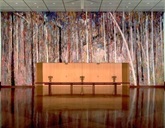
Great Hall Tapestry (1984‒1988), artist: by Arthur BOYD (1920‒1999), interpretation and execution: Victorian Tapestry Workshop (est. 1976) Wool, mercerised cotton and linen weft on a seine warp, 9m x 20m
Image courtesy of Parliament House Art Collection
|
|
1984
|
Parliament House Art Collection
|
|
| |
The Art Advisory Committee commences collecting, with the major purchasing of artworks taking place between 1985 and 1987.
The works form part of the Parliament House Art Collection which, by 2012, contains over 6000 art and craft works showcasing the work of emerging Australian artists and reflecting aspects of Australian culture, character and identity. [17]
|
|
|
1986
|
Budget cuts and reinstatement
|
|
| |
In August 1986 the Government directs the Parliament House Construction Authority to reduce expenditure on the new Parliament House by $43.3 million. [18]
The reduced budget results in a reduction in the landscape program and in the acquisition of commissioned art works. In 1987 $5 million is reinstated to the budget for landscape works, and another $5 million transferred from furniture to landscape. In the following year, a budget of $9.3 million is established for the post-construction phase. [19]
|
|
|
1987
|
New Speaker's chair
|
|
| |
On 6 October 1987, the Speaker, the Hon. Joan Child (ALP, Member for Henty, Vic., 1974‒5 and 1980‒90), advises the House of Representatives that the Joint Standing Committee on the New Parliament House Parliament had decided that the Speaker's Chair should not be transferred from the provisional Parliament House to the new building.
The Speaker presents the Committee's reasons for reconsidering its earlier decision, stating that:
This chair was a gift from the United Kingdom branch of the Empire Parliamentary Association. It is a replica of the original chair designed for the House of Commons chamber and contains timber from the Westminster Hall and from Nelson's flagship, HMS Victory. Presented in 1926, it has served as the Speaker's chair in this chamber for the whole of Parliament's occupation of this building. In doing so, the chair has become the central piece of this particular chamber, without which, I suggest, the chamber could become just another room. The design brief for the new Parliament House drew attention to the possibility that certain items might be transferred to the new building. One of these was the Speaker's chair. I have no doubt that in considering the matter last year the Joint Standing Committee made its decision to transfer the chair on the basis of tradition and the symbolic link with the Westminster Parliament.
In reviewing the decision, the Committee recognised these points; however, it also recognised the significance of preserving the integrity of the current chamber. It was felt that removal of the chair would completely destroy the character of the chamber and diminish its value as an historical testament to Australia's parliamentary development from 1927 to 1988. In this context it should be noted that in 1984 the Joint Standing Committee recommended that, after its vacation by the Parliament, this building should become a museum related to the Australian Constitution, Federation and the Commonwealth Parliament.
The new Parliament House will be a contemporary building, reflecting Australia's current traditions and values. It will incorporate a great deal of Australian skill, craftsmanship and materials. This will be particularly so in the two legislative chambers. Construction of the new building presents the opportunity for design and fabrication of a new chair in keeping with the distinctly Australian character of the new chamber. [20]
The Committee's decision is opposed by some members on the grounds that the transfer of the Speaker's Chair to the new building would symbolise the continuity of the Parliament and provide a visible link with the provisional Parliament House.
|
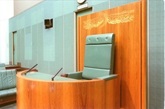
Speaker's Chair crafted by David Upfill-Brown, using Australian grey box timber with Tasmanian black-hearted sassafras and six types of Australian wattle
Image courtesy of AUSPIC
|